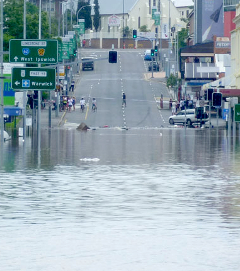City flooding studied
 Some Australian cities appear to be defying a global flooding trend.
Some Australian cities appear to be defying a global flooding trend.
Urbanisation is intensifying drought conditions in over half of the world’s cities, with the growing concentration of people in urban areas leading to warmer and drier environments, reducing light rainfall and exacerbating extreme local droughts.
However, Australian cities, particularly in South East Queensland, present a different picture, offering some hope amid this global concern.
A recent Chinese study analysed data from weather stations worldwide, finding that about 36 per cent of urban areas experienced worsening drought severity as cities expanded.
This was particularly evident in large cities with less green cover.
The researchers used a physics-based weather model to investigate this trend, finding that urbanisation often leads to reduced light rainfall, which in turn aggravates drought conditions.
“Urbanisation induced warmer and drier urban environments, which has suppressed light rainfall and aggravated extreme local drought conditions,” the study states.
Interestingly, the data revealed a surprising exception: South East Queensland cities bucked the trend, showing a decrease in drought severity with urbanisation.
These cities benefit from their coastal proximity, which provides a natural moisture source and moderates urban heat, leading to more favourable conditions.
This contrasts with the findings from Sydney, where urbanisation has contributed to worsening drought conditions.
The global projections are concerning.
By the mid-21st century, nearly 70 per cent of urban regions are expected to suffer from increased drought severity due to continued urban expansion.
This is largely attributed to the conversion of vegetated areas into impervious surfaces, which increases heat and reduces atmospheric humidity.
The researchers warn that this trend could hinder efforts to achieve several UN Sustainable Development Goals, particularly those related to clean water, sustainable cities, and life on land.
To mitigate these effects, the study suggests that cities should invest in nature-based solutions such as expanding urban green spaces.
These can help restore evapotranspiration, a key process in maintaining atmospheric moisture.
Additionally, cities should develop more flexible water supply systems, including desalination, rainwater harvesting, and greywater recycling, to improve resilience against drought.
The full study is accessible here.








 Print
Print